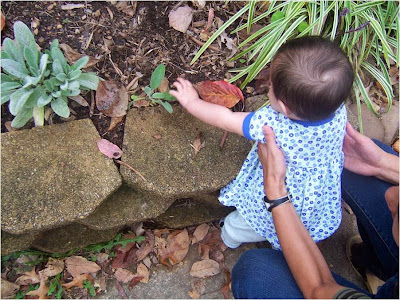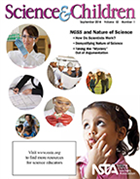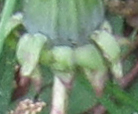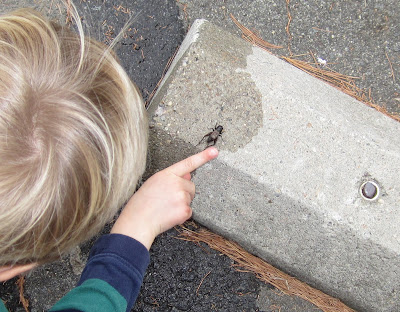When are children old enough to smell a flower, touch an earthworm, or talk about the Nature of Science (NOS)?
By Peggy Ashbrook
Posted on 2014-09-04
 When are children old enough to begin exploring the natural world? Can a three-year-old touch a crawling beetle? Can a two-year-old smell a flower; can a one-year-old? Can a 3-month-old feel a leaf? This question was raised in a recent training session about helping young children learn more about the small animals they are curious about: worms, insects and other small animals. People disagreed about what age would be appropriate to allow children these experiences but there was no disagreement about five-year-olds being ready to observe for longer periods and draw pictures of what they see. We also agreed that early childhood educators must know the children in their program and what activities they can safely engage in. As a family home child care provider I checked flowers for bees and others before bringing a child (including babies) close enough to smell—but not to taste! My yard only had plants that were not toxic so I did not have the lily-of-the-valley plants or wisteria vines that bear flowers I love to smell.
When are children old enough to begin exploring the natural world? Can a three-year-old touch a crawling beetle? Can a two-year-old smell a flower; can a one-year-old? Can a 3-month-old feel a leaf? This question was raised in a recent training session about helping young children learn more about the small animals they are curious about: worms, insects and other small animals. People disagreed about what age would be appropriate to allow children these experiences but there was no disagreement about five-year-olds being ready to observe for longer periods and draw pictures of what they see. We also agreed that early childhood educators must know the children in their program and what activities they can safely engage in. As a family home child care provider I checked flowers for bees and others before bringing a child (including babies) close enough to smell—but not to taste! My yard only had plants that were not toxic so I did not have the lily-of-the-valley plants or wisteria vines that bear flowers I love to smell.
See these sites to find out more about poisonous plants—no list is complete but they are a good place to begin learning.
- North Carolina Cooperative Extension list of plants. http://plants.ces.ncsu.edu/plants/plant-list
- The retailers code of practice for potentially harmful plants. (UK) Horticultural Trades Association, 2000; Guy’s & St Thomas’ Poisons Information Service and Royal Botanic Gardens, Kew 2008. http://www.kew.org/science/ecbot/HTA_code_list.pdf
- University of California, Safe and Poisonous Garden Plants. http://ucanr.edu/sites/poisonous_safe_plants/Safe_Plants_by_Common_Name/
- University of Vermont Extension System, Potentially Harmful Perennials OH 63. Leonard P. Perry, Extension Associate Professor. http://www.uvm.edu/~pass/perry/oh63harm.html
 Early childhood educators may also wonder when children are old enough to learn about the “Nature of Science” (NOS) or how science ‘works’. Researchers are also interested in what young children can understand about aspects of the nature of science—read the article, “Demystifying Nature of Science: Two activities help young children understand the nature of science” (Lederman et al 2014), in the September 2014 Science and Children. I also learned from studies by Akerson and Donnelly (2009, 2011) including “Teaching Nature of Science to K-2 Students: What understanding do they attain?” Children who have an understanding of the nature of science, or how science works, may be able to apply it to many situations, not only the times they know some information.
Early childhood educators may also wonder when children are old enough to learn about the “Nature of Science” (NOS) or how science ‘works’. Researchers are also interested in what young children can understand about aspects of the nature of science—read the article, “Demystifying Nature of Science: Two activities help young children understand the nature of science” (Lederman et al 2014), in the September 2014 Science and Children. I also learned from studies by Akerson and Donnelly (2009, 2011) including “Teaching Nature of Science to K-2 Students: What understanding do they attain?” Children who have an understanding of the nature of science, or how science works, may be able to apply it to many situations, not only the times they know some information.
Dr. Valarie L. Akerson, Professor of Science Education at Indiana University shares some thoughts: “Preschool and Kindergarten teachers are amazing! And they can definitely start young children in conceptualizing NOS from an early age. Research on young children’s understandings of NOS suggest a great strategy is to start with the concrete and move to the abstract, maintaining an emphasis on all NOS aspects throughout the course of the school year. A particularly favorite children’s book I have for NOS instruction is Jerry Pallotta’s “Skull Alphabet” which can be used to introduce and emphasize the distinction between observation and inference, the difference between evidence and observations, the importance of contextual clues, as well as background knowledge in making inferences.”
 In the September Early Years column, “The Nature of Science in Early Childhood,” I wrote about an activity to teach one aspect of the nature of science, understanding the difference between observation and inference. Children eagerly wondered what was pictured in their piece cut from a larger photograph of an unknown object. What could it be? Before I would listen to their inferences (what it could be), I asked them to simply describe their observations, what they did see–shapes, colors and any recognizable objects. What do you observe and what do you infer about this photo? See the full photo here.
In the September Early Years column, “The Nature of Science in Early Childhood,” I wrote about an activity to teach one aspect of the nature of science, understanding the difference between observation and inference. Children eagerly wondered what was pictured in their piece cut from a larger photograph of an unknown object. What could it be? Before I would listen to their inferences (what it could be), I asked them to simply describe their observations, what they did see–shapes, colors and any recognizable objects. What do you observe and what do you infer about this photo? See the full photo here.
 Other opportunities for teaching children the difference between describing what they notice and telling what they think it means can happen when observing and caring for animals in the classroom. While caring for classroom crickets, children make observations—they notice when a particular cricket stays inside a cardboard tube. “It misses its mommy” or, “It’s shy,” they say. These statements are their inferences—the children’s best possible explanations for the cricket’s behavior based on what they observe and their prior knowledge of animals, including themselves. We can help children begin to understand that their observation is different from the meaning they give to it, an inference. We can ask children, “Tell me what you observed and then tell me what you think is happening,” in any exploration. In later discussions we might ask, “Are there any other reasons why you, or another animal, like to be inside a cozy space?” Animated discussions where children talk about differing meanings inferred about the same observation are an important part of science. Children recall when they were in a cozy space pretending to be bunnies, or finding a quiet place to rest, or hide. Part of science inquiry is considering alternative explanations and it is okay if scientists (including children) don’t agree. Young children may not be able to investigate why that particular cricket often stays inside the tube, but they do notice patterns of behavior and communicate it through conversations, discussions and drawings.
Other opportunities for teaching children the difference between describing what they notice and telling what they think it means can happen when observing and caring for animals in the classroom. While caring for classroom crickets, children make observations—they notice when a particular cricket stays inside a cardboard tube. “It misses its mommy” or, “It’s shy,” they say. These statements are their inferences—the children’s best possible explanations for the cricket’s behavior based on what they observe and their prior knowledge of animals, including themselves. We can help children begin to understand that their observation is different from the meaning they give to it, an inference. We can ask children, “Tell me what you observed and then tell me what you think is happening,” in any exploration. In later discussions we might ask, “Are there any other reasons why you, or another animal, like to be inside a cozy space?” Animated discussions where children talk about differing meanings inferred about the same observation are an important part of science. Children recall when they were in a cozy space pretending to be bunnies, or finding a quiet place to rest, or hide. Part of science inquiry is considering alternative explanations and it is okay if scientists (including children) don’t agree. Young children may not be able to investigate why that particular cricket often stays inside the tube, but they do notice patterns of behavior and communicate it through conversations, discussions and drawings.
The entire September 2014 issue of Science and Children concerns the Nature of Science and the Next Generation Science Standards. A great resource for beginning the school year and deepening our own understanding!
Resources
Akerson, V. and Lisa A. Donnelly. 2009. Teaching Nature of Science to K-2 Students: What understandings can they attain?” International Journal of Science Education. 30 (1): 97-124
http://www.researchgate.net/publication/240526639_Teaching_Nature_of_Science_to_K-2_Students_What_understandings_can_they_attain
Akerson, V. and G. Buck, L. Donnelly, V. Nargund-Joshi and I. Weiland. 2011. The Importance of Teaching and Learning Nature of Science in the Early Childhood Years. Journal of Science Education and Technology. 20 (5): 537-549
http://link.springer.com/article/10.1007%2Fs10956-011-9312-5
Lederman, Judith and Selina Bartels, Norman Lederman and Dionysius Gnanakkan. 2014. “Demystifying Nature of Science: Two activities help young children understand the nature of science.” Science and Children. 52 (1): 40-45.
http://www.nsta.org/publications/browse_journals.aspx?action=issue&thetype=all&id=96700
Disclaimer: The views expressed in this blog post are those of the author(s) and do not necessarily reflect the official position of the National Science Teaching Association (NSTA).


